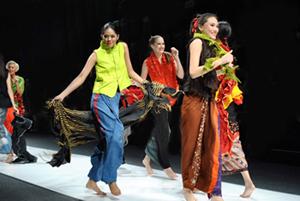For those of you who do not as yet know me, my name is Anastasia and I am reporting to you live from U.S.(alt). In the third part of my series (see Part I and Part II here), I will explore the subject of: FashionIt has been said that fashion is but a reflection of a culture and of it’s evolution (or devolution) in a given society, and a translation into fabric of what designers perceive as the wants, needs and tastes of the public they serve. To understand how the fashion trends in the U.S.(alt) of today came about, we have to go back to yesteryear, to the times before Purification Day. As you may recall, in those days, special interest groups were virtually running Congress(alt). One of the most ‘successful’ of these groups was the NRA(alt), which not only made it a point to block any legislation to control gun violence, they pushed through (read: financed) the enactment of new laws which effectively overrode or repealed any and all restrictions on gun ownership, making it possible for anyone, at any age, to buy as many weapons as they wanted. The motto, “The only one who can stop a bad man with a gun, is a good man with a gun”, was replaced with, “The only good man, is a man with a gun”, implying that anyone who didn’t own a gun was likely up to no good. In fact, owning a gun was touted as proof of goodwill towards one’s fellow man. In churches, that part of the mass which previously called for shaking hands, was changed; parishioners now clinked guns instead, crossing muzzles like swords. There were a few unfortunate incidences of heads being accidentally blown off, as one or the other of the ‘clinkers’ forgot to put the safety on and, caught up in their fervor of showing amity, squeezed the trigger just a wee bit too much. Guns became available for purchase everywhere, even in drug stores, which stocked these, conveniently, right next to shelves with bandages, gauze, wound disinfectants, antibiotics and, of course, something very potent to kill the pain, allowing survivors of gunshot wounds to trip and smile through their subsequent ordeal. The NRA(alt), by this time on a roll and virtually unstoppable, made an unholy alliance with a little known pharmaceutical company, whose already less than stellar reputation, was further beleaguered by a Justice Department(alt) investigation into their questionable business practices and inhumane treatment of laboratory animals. In return for a cut of profits from drug sales, the NRA(alt)first had the J.D.(alt) investigation quashed, and then managed to declassify the said pharmaceutical company’s powerful pain killer, aptly called ‘Blaid’ (short for Bullet-Aid), so that it no longer required a prescription for purchase but instead, could be sold over the counter. The design of semi-automatic assault rifles, particularly popular among citizens hell-bent on visibly demonstrating their goodness, was improved, allowing users to upgrade these to ‘full automatic’ by the simple flip of a switch. This, of course, increased the weapon’s rate of fire or RPM (rounds per minute) so naturally, large capacity magazines had to be made even larger. Unfortunately, material cooling remained a problem. Many hospital E.R.’s reported a marked increase in incidences of ‘trigger finger burn’ due to rifles overheating. Overheating also caused a phenomenon called ‘cook-off’ where ammunition was discharged from a rifle unintentionally. In instances where this resulted in someone being wounded or killed, the alleged shooters used the, “It wasn’t me, it was the gun” defense, invariably availing themselves of free legal services provided by the NRA(alt). A well-know company, already one of the leading retailers of weapons in the country, opened a new chain of stores called Walguns(alt). To the charge that owners of this behemoth of a company were enriching themselves at the expense of public safety, and therefore had the blood of victims on their hands, a spokesman for the family countered with the well-worn mantra that “Guns don’t kill people, people kill people” and that was that.
 What does all of this have to do with fashion? You may well ask. The answer is that, finding ourselves in this gun-infested environment, camouflage clothing of all kinds became all the rage, as it was a combination fashion statement and life-saving necessity when going out into the open. As an example, let us look at what was ‘de rigueur’ to wear when grocery shopping. If one managed to get to a supermarket without running into someone armed with a lethal weapon and a bad case of road rage, one was well advised to wear clothing which permitted one to blend in with the background in case bullets started flying as, unfortunately, they often did. For this reason, clothes designed for comestibles shopping occasions, were made of fabrics imprinted with various horizontal patterns which replicated the appearance of shelves of foodstuffs. With any luck, one could press one’s back against actual shelves in the supermarket, hopefully diminishing one’s visibility.It didn’t take long for the majority of retail business of all kinds, to have a dedicated section of clothing, depicting their particular interiors, right by the store’s entrance, for the possibly life-saving benefit of their patrons. As wardrobes now reflected one’s shopping habits, they were also a very visible testimonial to one’s financial wherewithal (if not very flattering to the figure). Some people who did not have the means to shop in high end stores or boutiques, bought the camouflage clothing of those places anyway, and then took their lives into their own hands wearing these to establishments they customarily frequented, ergo could afford, prompting the expression “Il faut souffrir pour être belle” (“You have to suffer to be beautiful”) to take on a whole new meaning.After Purification Day, we enacted extremely strict gun control laws. Mandatory instruction in use and annual re-qualification, was ordered for all those who possessed a gun, since there was more than ample evidence suggesting that a large percentage of owners had little or no shooting skills at all, many finding hitting a billboard at point blank range, problematic. Constitution2.0 did not now include the Second Amendment since the British(alt) swore up and down, on everything that is holy, that they had no intention of colonizing us ever again, and neither our immediate neighbors nor anybody else, for that matter, showed any inclinations pointing in that direction. In light of that, “A well regulated Militia, being necessary to the security of a free State, the right of the people to keep and bear Arms, shall not be infringed.”, was a safeguard which, clearly, became academic.Not surprisingly, there was little opposition to these changes because all of us, including even the most ardent gun enthusiasts, had had enough of senseless killing, of mass murders, of children shooting each other by accident, of disputes being resolved with the business end of a gun, of injury and death by “wrong time, wrong place”, of not a single day going by without yet another news story involving guns and death. The fashion industry, reacting, as always, to cultural changes and to our wants, needs and tastes, now designs clothing made of the most colorful fabrics possible, replacing years of drab, the only purpose of which, was to help blend us into the woodwork. To describe an outfit as “garish” is to give it high praise indeed; to call it “camouflage” is to denigrate it in the worst way possible. Evening wear, which heretofore involved covering up from head to foot to decrease one’s visibility to the max, is back in styles revealing, and made of fabrics downright neon.
What does all of this have to do with fashion? You may well ask. The answer is that, finding ourselves in this gun-infested environment, camouflage clothing of all kinds became all the rage, as it was a combination fashion statement and life-saving necessity when going out into the open. As an example, let us look at what was ‘de rigueur’ to wear when grocery shopping. If one managed to get to a supermarket without running into someone armed with a lethal weapon and a bad case of road rage, one was well advised to wear clothing which permitted one to blend in with the background in case bullets started flying as, unfortunately, they often did. For this reason, clothes designed for comestibles shopping occasions, were made of fabrics imprinted with various horizontal patterns which replicated the appearance of shelves of foodstuffs. With any luck, one could press one’s back against actual shelves in the supermarket, hopefully diminishing one’s visibility.It didn’t take long for the majority of retail business of all kinds, to have a dedicated section of clothing, depicting their particular interiors, right by the store’s entrance, for the possibly life-saving benefit of their patrons. As wardrobes now reflected one’s shopping habits, they were also a very visible testimonial to one’s financial wherewithal (if not very flattering to the figure). Some people who did not have the means to shop in high end stores or boutiques, bought the camouflage clothing of those places anyway, and then took their lives into their own hands wearing these to establishments they customarily frequented, ergo could afford, prompting the expression “Il faut souffrir pour être belle” (“You have to suffer to be beautiful”) to take on a whole new meaning.After Purification Day, we enacted extremely strict gun control laws. Mandatory instruction in use and annual re-qualification, was ordered for all those who possessed a gun, since there was more than ample evidence suggesting that a large percentage of owners had little or no shooting skills at all, many finding hitting a billboard at point blank range, problematic. Constitution2.0 did not now include the Second Amendment since the British(alt) swore up and down, on everything that is holy, that they had no intention of colonizing us ever again, and neither our immediate neighbors nor anybody else, for that matter, showed any inclinations pointing in that direction. In light of that, “A well regulated Militia, being necessary to the security of a free State, the right of the people to keep and bear Arms, shall not be infringed.”, was a safeguard which, clearly, became academic.Not surprisingly, there was little opposition to these changes because all of us, including even the most ardent gun enthusiasts, had had enough of senseless killing, of mass murders, of children shooting each other by accident, of disputes being resolved with the business end of a gun, of injury and death by “wrong time, wrong place”, of not a single day going by without yet another news story involving guns and death. The fashion industry, reacting, as always, to cultural changes and to our wants, needs and tastes, now designs clothing made of the most colorful fabrics possible, replacing years of drab, the only purpose of which, was to help blend us into the woodwork. To describe an outfit as “garish” is to give it high praise indeed; to call it “camouflage” is to denigrate it in the worst way possible. Evening wear, which heretofore involved covering up from head to foot to decrease one’s visibility to the max, is back in styles revealing, and made of fabrics downright neon. 
These days we want to be seen, and in technicolor! The key word in the fashion of today is visibility, celebrating the return of sanity and of safety and of the idea that the most important right any of us have, before all else, is the right to live!
Next time, the subject will be tourism. Till then, this has been,A. J. Aston Reporting to you live from the United States(alt)Article first published as An Alternate Reality United States, Part III: Fashion on Blogcritics.

